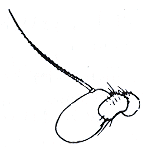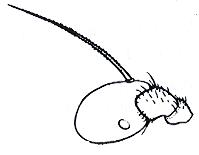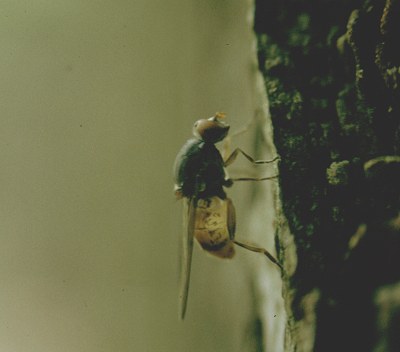8.a.
Abdomen, middle and hind coxae pale, reddish brown to orange; male eyes holoptic or approximate, separated by less than aristal width; antennal segment 3 with or without a distinct sensory pit -> 9
8.b. Abdomen, middle and hind coxae dark, brownish black to black; male eyes distinctly dichoptic, separated by much more than aristal width; antennal segment 3 without a distinct sensory pit -> iv
9.a. Antennal segment 3 without a sensory pit; notopleuron extensively pale pilose -> i
9.b. Antennal segment 3 with a small sensory pit; notopleuron black pilose -> Brachyopa bicolor (Fallen)
 |
Fig. a. Brachyopa insensilis, antenna. |
 |
Fig. b. Brachyopa bicolor, antenna. |
i.a. Scutellum entirely covered in microtrichia; mediotergite (between subscutellum and abdomen, visible if abdomen is bent downwards) bare of microtricha in lower half; propleuron pilose; femur 3 thick: length:width ratio in males smaller than 4.5, in females smaller than 5 -> ii
i.b. Scutellum largely bare of microtrichia, except for anterior margin; mediotergite almost entirely microtrichose; ; propleuron (proepimeron) bare; femur 3 slender: length:width ratio in males larger than 5, in females larger than 5.5. -> Brachyopa insensilis Collin
ii.a. Hypostomal bridge (mid ventral plate of the head) blackish; mesonotum either with an undusted triangular spot at the suture (B. silviae) or without bare spot there (B. grunewaldensis); clypeus wider, more truncate (length:width=1-1.7); tibia 1 and 3 and dorsal surface of tars 1, 2 and 3 entirely pale haired with at most a few black hairs mixed in -> iii
ii.b. Hypostomal bridge yellow; mesonotum with one pair of undusted roundish spots at the transverse suture; clypeus slender (length:width=1.8-2.1); tibia 1 and 3 and tars 1, 2 and 3 black haired; -> Brachyopa bimaculosa Doczkal and Dziock 2004
Note: photos 28-29 in Doczkal and Dziock (2004) show that the central dusted, pale longitudinal stripe in between the two dark stripes on the mesonotum is as broad as each dark one in B. bimaculosa, while it is much smaller in B. silviae.
iii.a. Mesonotum with a pair of undusted almost triangular spots at the transverse suture; face more protruding; head: bare spots posterior to the ocelli lack; postalar calli entirely microtrichose. Male: apex of tibia 3 ventrally with a narrow, sharp edge acros full width. -> Brachyopa silviae Doczkal and Dziock 2004
iii.b. Mesonotum without bare spots; face less protruding; head: bare spot posterolateral to ocelli present; postalar calli with a spot bare of microtrichia. Male: apex of tibia 3 ventrally with a narrow sharp edge restricted to the posterior threequarters of the apical margin -> Brachyopa grunewaldensis Kassebeer 2000
iv.a Abdominal tergites with apical margins pollinose and pale, yellow to white; scutellum black on basal 2/3, orange apically, entirely long erect pale yellow pilose -> Brachyopa ornamentosa Violovitsh
iv.b. Abdominal tergites shiny, uniformly dark; scutellum orange, short appressed black pilose -> Brachyopa cinerea Wahlberg
Doczkal D. and Dziock F. 2004. Two new species of Brachyopa Meigen from Germany, with notes on B. grunewaldensis Kassebeer (Diptera, Syrphidae). Volucella 7: 35-60.
Goot, V. S. van der, 1981. De zweefvliegen van Noordwest-Europa en Europees Rusland, in het bijzonder de Benelux. - Bibl. K. Ned. Natuurh. Veren. 32: 1-274.



